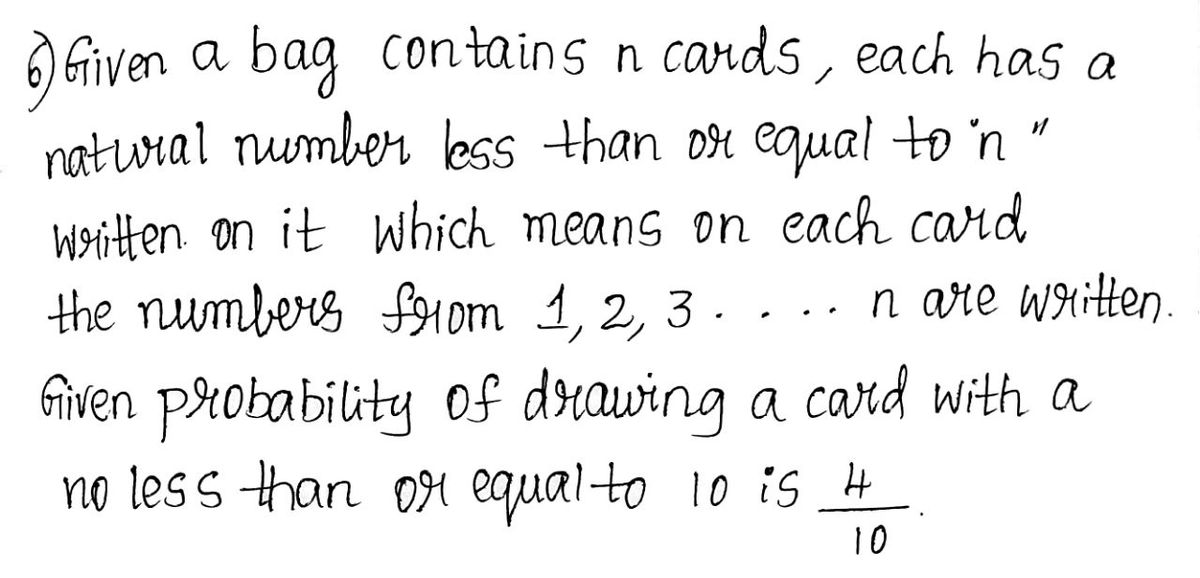6. A bag contains n cards, each having a f than or equal to n written on it, with each number being used once. The probability of drawing a card with a num- How many cards are in 4 ber less than or equal to 10 is 10 the bag? 7. For each of the following scenarios, rate the probability of it occurring as Impossible, Unlikely, Neither Unlikely nor Likely, Likely, Certain. a. A die is rolled, and it lands on a prime number. b. A red card is drawn out of a standard deck of 52 cards, c. A die is rolled, and it lands on a number larger than six. d. You will not win the lottery jackpot if you buy one ticket. e. A fair coin is flipped 4 times, and each time it has landed on "tails"; the next flip will also be tails. 8. Decide whether each of the following pairs of events are mutually exclusive or not mutually exclusive when rolling one die: a. The number is even and the number is odd. b. The number is even and the number is prime. he number is divisible by 3 and the number is 14
6. A bag contains n cards, each having a f than or equal to n written on it, with each number being used once. The probability of drawing a card with a num- How many cards are in 4 ber less than or equal to 10 is 10 the bag? 7. For each of the following scenarios, rate the probability of it occurring as Impossible, Unlikely, Neither Unlikely nor Likely, Likely, Certain. a. A die is rolled, and it lands on a prime number. b. A red card is drawn out of a standard deck of 52 cards, c. A die is rolled, and it lands on a number larger than six. d. You will not win the lottery jackpot if you buy one ticket. e. A fair coin is flipped 4 times, and each time it has landed on "tails"; the next flip will also be tails. 8. Decide whether each of the following pairs of events are mutually exclusive or not mutually exclusive when rolling one die: a. The number is even and the number is odd. b. The number is even and the number is prime. he number is divisible by 3 and the number is 14
A First Course in Probability (10th Edition)
10th Edition
ISBN:9780134753119
Author:Sheldon Ross
Publisher:Sheldon Ross
Chapter1: Combinatorial Analysis
Section: Chapter Questions
Problem 1.1P: a. How many different 7-place license plates are possible if the first 2 places are for letters and...
Related questions
Question
# 7 A-E

Transcribed Image Text:nu
6. A bag contains n cards, each having a natural
than or equal to n written on it, with each number being
used once. The probability of drawing a card with a num-
How many cards are in
4
ber less than or equal to 10 is
the bag?
10
7. For each of the following scenarios, rate the probability
of it occurring as Impossible, Unlikely, Neither Unlikely nor
Likely, Likely, Certain.
a. A die is rolled, and it lands on a prime number.
b. A red card is drawn out of a standard deck of 52
cards.
c. A die is rolled, and it lands on a number larger than
six.
d. You will not win the lottery jackpot if you buy one
ticket.
e. A fair coin is flipped 4 times, and each time it has
landed on "tails"; the next flip will also be tails.
8. Decide whether each of the following pairs of events are
mutually exclusive or not mutually exclusive when rolling
one die:
a. The number is even and the number is odd.
b. The number is even and the number is prime.
c. The number is divisible by 3 and the number is
0,0
the
a.
b.
14. St
b
S
15
Expert Solution
Step 1
Please note that as per our guidelines if multiple questions are posted we can answer the first question. Please repost the remaining questions separately to get the answers. Thank you.

Step by step
Solved in 4 steps with 4 images

Recommended textbooks for you

A First Course in Probability (10th Edition)
Probability
ISBN:
9780134753119
Author:
Sheldon Ross
Publisher:
PEARSON


A First Course in Probability (10th Edition)
Probability
ISBN:
9780134753119
Author:
Sheldon Ross
Publisher:
PEARSON
